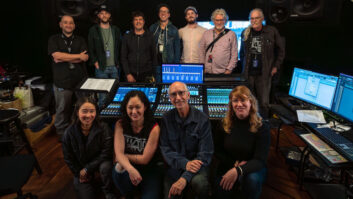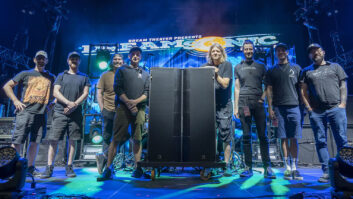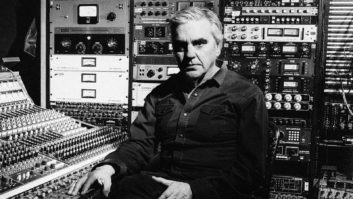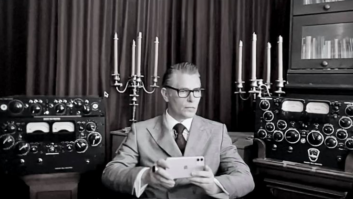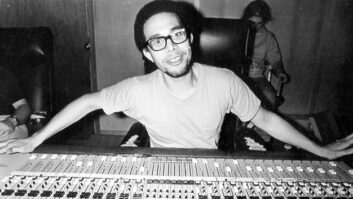“A lot of people who record with me are not necessarily the most together or stable, and the music they make is often disturbing and heavy,” laughs noted underground sound sculptor Steve Austin. “In fact, during the first night of recording with one band, who had been on a major label and opened for Pantera, blood was spilled by two different people. Furthermore, my shirt was ripped off my back, and some of the heaviest music on the Earth was committed to tape, all in the space of a few hours.”
Austin is a fearless, driven guitar player in the vein of John McLaughlin or Robert Fripp, with an added affinity for death metal. Experienced in both the touring circuit trenches and behind the console, this Tennessee native maintains both of the vitally important vantage points for a modern engineer.
“My live room tracking method is the same as how BBC Peel Sessions are recorded,” says Austin, speaking from his home recording/mastering facility, Austin Enterprise, in placid Clinton, Mass. “I recorded at the BBC with Today Is the Day in the mid-1990s, and it was probably the most powerful recording experience I had ever had, and the most accurate recording of my music. It was set up more like an old-school recording, where everyone plays in the same room separated by acoustic dividers.
“At Austin Enterprise, I have a seven-foot-high mahogany barricade that wraps around the drum set. The guitar amps are put 10 feet ahead of the drums facing forward. This technique gets super separation but allows everyone to be in the same room at the same time. To me, recording is not based around the technicalities of numbers, digits, dBs and ratios, but around giving the artists a place where they feel super comfortable; and a place where they’ll be able to hear themselves, hear the drummer, play accurately and enjoy a real experience.”
The Trident 24 36×24×24 mixing console, like most of the gear at the studio, has been hot-rodded. “Stock gear just can’t cut it,” notes Austin. “Almost everything I have has been ‘mod-ed’ by Coleman Rodgers of Alactronics in Wellesley, Massachusetts. I consider Coleman a genius and personal guru.”
Austin’s prized gear includes a pair of silver-faced UREI LA4 optocompressors. All vocals are double-compressed with an early violet-shaded UREI 1176LN (D) and a Drawmer 1960 tube mic pre/limiter. A Neumann M147 tube condenser provides the up-close mic, while an STC 4038 ribbon mic soaks up the ambient room sound. Austin recently acquired a bronze STC 4038 mic — in fact, the second-earliest existing one, according to Wes Dooley of AEA.
“A lot of the stuff we cut here is through vintage preamps,” Austin adds. “We have a pair of Neve 1272s that I use for guitar and vocals, and four Telefunken V72s for stereo room tracks, hi-hat and ride. For kick, snare and toms, I use four API 312s and a Drawmer 1960 dual-tube mic preamp, and Countryman 85 FET for bass.”
The live room, which measures 16×32 feet with a 12-foot ceiling, features a floated, beech hardwood floor and 5-inch-thick walls, producing a formidable natural reverb.
Austin Enterprise hosts, naturally, both of Austin’s bands: Today Is the Day is one of extreme music’s most splenetic, progressive, technical outfits; and Taipan, Austin’s newest foray, is a more direct, linear, avant-rock trio. Outside clients who venture into Austin Enterprise, including such notables as Metal Blade artists Lamb of God, New York City noise trio Unsane, Deadguy and the infamous A.C., are recorded to Austin’s mint-condition Studer A80 Mark IV 2-inch tape machine.
“Steve Smith of Studer Nashville resurfaced and hot-rodded our capstan motor,” notes Austin. “[The Studer] already had the Gizmo mod, which is the gold stabilizer pin that appears on the later Studer A827 tape path. I run the machine at 15 ips, which produces a 50Hz low-frequency response.
“The bottom line for me is that if I am getting off on the mix, and if it’s good, I lose control,” explains Austin. “I’ll find myself flying out of my engineer’s chair and completely freaking out because the music rocks me that hard. That’s when I stop the song, prepare the mix-down deck and lay those songs down. Ultimately, it’s about getting people to just let it fly without restrictions.”
You can visit Austin Enterprise at www.austinenterprise.com. Also, check out Austin’s band at www.todayistheday.org.
Patrick Kennedy is a freelance writer based in Baltimore.
